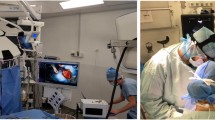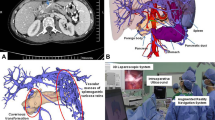Abstract
Background
We applied a new concept of “image overlay surgery” consisting of the integration of virtual reality (VR) and augmented reality (AR) technology, in which dynamic 3D images were superimposed on the patient’s actual body surface and evaluated as a reference for surgical navigation in gastrointestinal, hepatobiliary and pancreatic surgery.
Methods
We carried out seven surgeries, including three cholecystectomies, two gastrectomies and two colectomies. A Macintosh and a DICOM workstation OsiriX were used in the operating room for image analysis. Raw data of the preoperative patient information obtained via MDCT were reconstructed to volume rendering and projected onto the patient's body surface during the surgeries. For accurate registration, OsiriX was first set to reproduce the patient body surface, and the positional coordinates of the umbilicus, left and right nipples, and the inguinal region were fixed as physiological markers on the body surface to reduce the positional error.
Results
The registration process was non-invasive and markerlesss, and was completed within 5 min. Image overlay navigation was helpful for 3D anatomical understanding of the surgical target in the gastrointestinal, hepatobiliary and pancreatic anatomies. The surgeon was able to minimize movement of the gaze and could utilize the image assistance without interfering with the forceps operation, reducing the gap from the VR. Unexpected organ injury could be avoided in all procedures. In biliary surgery, the projected virtual cholangiogram on the abdominal wall could advance safely with identification of the bile duct. For early gastric and colorectal cancer, the small tumors and blood vessels, which usually could not be found on the gastric serosa by laparoscopic view, were simultaneously detected on the body surface by carbon dioxide-enhanced MDCT. This provided accurate reconstructions of the tumor and involved lymph node, directly linked with optimization of the surgical procedures.
Conclusions
Our non-invasive markerless registration using physiological markers on the body surface reduced logistical efforts. The image overlay technique is a useful tool when highlighting hidden structures, giving more information.








Similar content being viewed by others
References
Tang SL, Kwoh CK, Teo MY, Sing NW, Ling KV. Augmented reality systems for medical applications. IEEE Eng Med Biol Mag. 1998;17:49–58.
Marescaux J, Rubino F, Arenas M, Mutter D, Soler L. Augmented-reality-assisted laparoscopic adrenalectomy. JAMA. 2004;292:2214–5.
Shuhaiber JH. Augmented reality in surgery. Arch Surg. 2004;139:170–4.
Milgram P, Kishino AF. Taxonomy of mixed reality visual displays. IEICE Trans Inform Syst 1994; E77-D:1321–9.
Rosset A, Spadola L, Ratib O, Osiri X. An open-source software for navigating in multidimensional DICOM images. J Digit Imaging. 2004;17:205–16. (Epub ahead of print).
Rosset C, Rosset A, Ratib O. General consumer communication tools for improved image management and communication in medicine. J Digit Imaging. 2005;18:270–9.
Rosset A, Spadola L, Pysher L, Ratib O. Informatics in radiology (infoRAD): navigating the fifth dimension: innovative interface for multidimensional multimodality image navigation. Radiographics. 2006;26:299–308.
Bauernschmitt R, Feuerstein M, Traub J, Schirmbeck EU, Klinker G, Lange R. Optimal port placement and enhanced guidance in robotically assisted cardiac surgery. Surg Endosc. 2007;21:684–7. (Epub 2006 Dec 16).
Fichtinger G, Deguet A, Masamune K, Balogh E, Fischer GS, Mathieu H, et al. Image overlay guidance for needle insertion in CT scanner. IEEE Trans Biomed Eng. 2005;52:2–1415.
Das M, Sauer F, Schoepf UJ, Khamene A, Vogt SK, Schaller S, et al. Augmented reality visualization for CT-guided interventions: system description, feasibility, and initial evaluation in an abdominal phantom. Radiology. 2006;240:230–5. (Epub 2006 May 23).
Nicolau SA, Pennec X, Soler L, Ayache N. A complete augmented reality guidance system for liver punctures: first clinical evaluation. Med Image Comput Comput Assist Interv Int Conf Med Image Comput Comput Assist Interv. 2005;8:539–47.
Deutschmann H, Steininger P, Nairz O, Kopp P, Merz F, Wurstbauer K, et al. “Augmented reality” in conventional simulation by projection of 3-D structures into 2-D images: a comparison with virtual methods. Strahlenther Onkol. 2008;184:93–9.
Iseki H, Masutani Y, Iwahara M, Tanikawa T, Muragaki Y, Taira T, et al. Volumegraph (overlaid three-dimensional image-guided navigation): clinical application of augmented reality in neurosurgery. Stereotact Funct Neurosurg. 1997;68:18–24.
Masutani Y, Dohi T, Yamane F, Iseki H, Takakura K. Augmented reality visualization system for intravascular neurosurgery. Comput Aided Surg. 1998;3:239–47.
Lovo EE, Quintana JC, Puebla MC, Torrealba G, Santos JL, Lira IH, et al. A novel, inexpensive method of image coregistration for applications in image-guided surgery using augmented reality. Neurosurgery. 2007;60:366–71. discussion 371–2.
Ackerman JD, Keller K, Fuchs H. Real-time anatomical 3D image extraction for laparoscopic surgery. Stud Health Technol Inform. 2001;81:18–22.
Kawamata T, Iseki H, Shibasaki T, Hori T. Endoscopic augmented reality navigation system for endonasal transsphenoidal surgery to treat pituitary tumors: technical note. Neurosurgery. 2002;50:1393–7.
Falk V, Mourgues F, Vieville T, Jacobs S, Holzhey D, Walther T, et al. Augmented reality for intraoperative guidance in endoscopic coronary artery bypass grafting. Surg Technol Int. 2005;14:231–5.
Ukimura O, Gill IS. Imaging-assisted endoscopic surgery: Cleveland clinic experience. J Endourol. 2008;22:803–10.
Nakamoto M, Nakada K, Sato Y, Konishi K, Hashizume M, Tamura S. Intraoperative magnetic tracker calibration using a magneto-optic hybrid tracker for 3-D ultrasound-based navigation in laparoscopic surgery. IEEE Trans Med Imaging. 2008;27:255–70.
Yuan ML, Ong SK, Nee AY. Registration using natural features for augmented reality systems. IEEE Trans Vis Comput Graph. 2006;12:569–80.
Marmulla R, Lüth T, Mühling J, Hassfeld S. Markerless laser registration in image-guided oral and maxillofacial surgery. J Oral Maxillofac Surg. 2004;62:845–51.
Comport AI, Marchand E, Pressigout M, Chaumette F. Real-time markerless tracking for augmented reality: the virtual visual serving framework. IEEE Trans Vis Comput Graph. 2006;12:615–28.
Marmulla R, Mühling J, Wirtz CR, Hassfeld S. High-resolution laser surface scanning for patient registration in cranial computer-assisted surgery. Minim Invasive Neurosurg. 2004;47:72–8.
Uenohara M, Kanade T. Vision-based object registration for real-time image overlay. Comput Biol Med. 1995;25:249–60.
Sugimoto M, Yasuda H, Koda K, Suzuki M, Yamazaki M, Tezuka T, et al. Evaluation for transvaginal and transgastric NOTES cholecystectomy in human and animal natural orifice translumenal endoscopic surgery. J Hepatobiliary Pancreat Surg. 2009;16:255–60. (Epub 2009 Apr 10).
Sugimoto M. Natural orifice translumenal endoscopic surgery (NOTES) for innovation in hepatobiliary and pancreatic surgery: preface. J Hepatobiliary Pancreat Surg. 2009;16:247–8. (Epub 2009 Apr 14).
Sugimoto M, Yasuda H, Koda K, Suzuki M, Yamazaki M, Tezuka T, et al. Rendezvous gastrotomy technique using direct percutaneous endoscopic gastrostomy for transgastric cholecystectomy in hybrid natural orifice translumenal endoscopic surgery. J Hepatobiliary Pancreat Surg. 2009. doi:10.1007/s00534-009-0143-1. (Epub 2009 Jul 15).
Vosburgh KG, San José Estépar R. Natural orifice transluminal endoscopic surgery (NOTES): an opportunity for augmented reality guidance. Stud Health Technol Inform. 2007;125:485–90.
Estépar RS, Stylopoulos N, Ellis R, Samset E, Westin CF, Thompson C, et al. Towards scarless surgery: an endoscopic ultrasound navigation system for transgastric access procedures. Comput Aided Surg. 2007;12:311–24.
Acknowledgments
This study was partially supported by a grant-in-aid from the Scientific Research Japan Society for the Promotion of Science, a JFE grant from the Japanese Foundation for Research and Promotion of Endoscopy, and the Teikyo University Tomoko Fujii memorial research grant for young medical researchers.
Author information
Authors and Affiliations
Corresponding author
About this article
Cite this article
Sugimoto, M., Yasuda, H., Koda, K. et al. Image overlay navigation by markerless surface registration in gastrointestinal, hepatobiliary and pancreatic surgery. J Hepatobiliary Pancreat Sci 17, 629–636 (2010). https://doi.org/10.1007/s00534-009-0199-y
Received:
Accepted:
Published:
Issue Date:
DOI: https://doi.org/10.1007/s00534-009-0199-y




